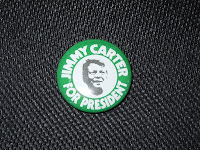This is the fourth post in a series about the American Civil Liberties Union of Georgia Records, which were processed in 2015 and are now open for research. These records document the ACLU of Georgia's litigation, lobbying, and public education efforts to protect civil liberties for all Georgians. Their work, which began in 1963, involves issues such as freedom of speech and assembly, freedom of the press, freedom of religion, due process of law, and opposing discrimination against many groups. This series of posts was written by Shaniqua Singleton, a student at the UGA School of Law, who was instrumental in processing these papers.
The United States is a rich melting pot of cultures and ethnic groups. One can drive through Athens and find many places of worship. The United States Constitution reflects this religious and cultural diversity, stating “Congress shall make no law respecting an establishment of religion, or the free exercise thereof.” The ACLU also holds tolerance of and respect for freedom of religion in high regard, and has been at the forefront of a number of legal and legislative battles to protect that right.
For example, the ACLU of Georgia’s records contain a number of challenges to displays of the Ten Commandments on state-owned property. In Turner v. Habersham County (2002-2003) the ACLU challenged a display of the Ten Commandments at the county courthouse. Researchers will find in these records photographs of the display and letters from the general public expressing support for and opposition to efforts to remove it. Researchers will also find documents outlining the ACLU’s legal arguments for why the display should be removed and press releases explaining its decision to move forward with the litigation.
Similarly, other records exemplify the ACLU’s challenges to depictions of the Ten Commandments on county seals and other documents authored by the county, including Doe v. Barrow County and King v. Richmond County. Perhaps the most interesting part of these records is a series of surveys conducted by the ACLU to determine whether members of the public associated a symbol of two stone tablets with the Ten Commandments. Beyond this, researchers will find expert testimony and scholarly opinions on the symbolism behind depictions of stone tablets, and court documents from the ACLU discussing these findings.
The ACLU has also challenged invocations at public meetings when they made reference to a specific religion (Pelphrey v. Cobb County - 2005-2008) and disclaimers regarding evolution in school textbooks (Selman v. Cobb County - 2002-2006), protected the rights of people to wear religious attire in public places like schools and courtrooms, challenged official school prayer and other religious observances in schools, and opposed faith-based legislation that provides government funding to programs run by religious organizations. In each of these challenges, the ACLU’s position has been the same: government should avoid establishing, explicitly or implicitly, a national religion and should not interfere with an individual’s right to practice their religion.
The ACLU regards freedom of religion as one of the bedrocks of our constitutional rights and defends both religious and secular viewpoints to uphold this right. Researchers interested in tangible examples of the ACLU’s work in defending religious freedom and challenging perceived violations of said right will find a wealth information in these records.
 |
| "Coalition to Protect Georgia's Bill of Rights," flyer in opposition to SR 49, amending Georgia's constitutional provision governing religious freedom, ca. 2005. Source: Series IV, Box 3, Folder 20. |
 |
| Flyer in opposition to HB 941 to allow local governments to display copies of the Ten Commandments, ca. 2006. Source: Series IV, Box 2, Folder 37. |
For example, the ACLU of Georgia’s records contain a number of challenges to displays of the Ten Commandments on state-owned property. In Turner v. Habersham County (2002-2003) the ACLU challenged a display of the Ten Commandments at the county courthouse. Researchers will find in these records photographs of the display and letters from the general public expressing support for and opposition to efforts to remove it. Researchers will also find documents outlining the ACLU’s legal arguments for why the display should be removed and press releases explaining its decision to move forward with the litigation.
Similarly, other records exemplify the ACLU’s challenges to depictions of the Ten Commandments on county seals and other documents authored by the county, including Doe v. Barrow County and King v. Richmond County. Perhaps the most interesting part of these records is a series of surveys conducted by the ACLU to determine whether members of the public associated a symbol of two stone tablets with the Ten Commandments. Beyond this, researchers will find expert testimony and scholarly opinions on the symbolism behind depictions of stone tablets, and court documents from the ACLU discussing these findings.
 |
| Cover of ACLU of North Carolina publication, "God & Country in the Public Schools," undated. Source: Series II, Box 45, Folder 13. |
The ACLU has also challenged invocations at public meetings when they made reference to a specific religion (Pelphrey v. Cobb County - 2005-2008) and disclaimers regarding evolution in school textbooks (Selman v. Cobb County - 2002-2006), protected the rights of people to wear religious attire in public places like schools and courtrooms, challenged official school prayer and other religious observances in schools, and opposed faith-based legislation that provides government funding to programs run by religious organizations. In each of these challenges, the ACLU’s position has been the same: government should avoid establishing, explicitly or implicitly, a national religion and should not interfere with an individual’s right to practice their religion.
 |
| Logo of "Sybil Liberty," from ACLU Briefer on religious freedom in schools, undated. Source: Series II, Box 37, Folder 18. |

























